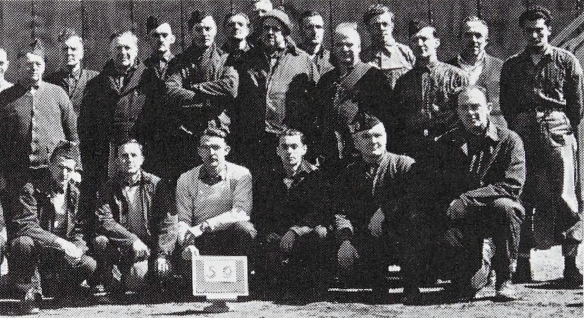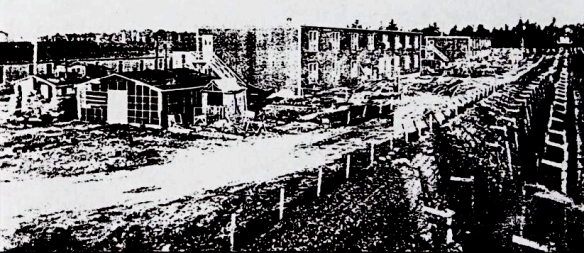|
|
Arcand and his men on July 1st, 1938.
July 1st, 1940, they are in concentration camps.

FIRST CONVENTION OF THE NATIONAL UNITY PARTY OF CANADA 1 JULY 1938. First row, from left to right: Henri Arcand, Gaétan Racicot, Daniel O’Keefe, John Cole, Maurice Scott, Adrien Arcand, Joseph Farr, William Duncan, Stanley Chopp, C.S. Thomas, William McDuff. Second row: John S. Lynds, Marius Gatien, A.G. Smale, John Schio, Jean T. Ramacière, Orner E. Gobeille, Fortunat Bleau, François Padulo, Roméo Biaise, Jean Mercier. Third row: Dr. Massina, Hugues Clément, Blaise Lavoie, Louis Leroux, W. Sketcher (or Schecter), Donat Boulanger, E.C. Miller, Leo Brunet, J. Duncan, Gérard Lanctôt.
PREMIER CONGRÈS DU PARTI DE L’UNITÉ NATIONAL DU CANADA, 1er JUILLET 1938. Première rang, de gauche à droite: Henri Arcand, Gaétan Racicot, Daniel O’Keefe, John Cole, Maurice Scott, Adrien Arcand, Joseph Farr, William Duncan, Stanley Chopp, C.S. Thomas, William McDuff. Deuxième rang: John S. Lynds, Marius Gatien, A.G. Smale, John Schio, Jean T. Ramacière, Orner E. Gobeille, Fortunat Bleau, François Padulo, Roméo Biaise, Jean Mercier. Troisième rang: Dr. Massina, Hugues Clément, Blaise Lavoie, Louis Leroux, W. Sketcher (or Schecter), Donat Boulanger, E.C. Miller, Leo Brunet, J. Duncan, Gérard Lanctôt.
Source: Library and Archives Canada, RG146, volume 3516, file “PUNC, Montréal”, pocket 2. Bibliothèque et Archives Canada, RG146, volume 3516, dossier « PUNC, Montréal », pochette 2.

While Ernest Lapointe was Minister of Justice in Ottawa, the French-Canadian detainees, deemed stateless, endured a thousand harassments. If they refused to work, they wound up in a cell.

Major Maurice J. Scott.* A strict disciplinarian, he drills his legions – without arms, but in military formations – to a major-general’s taste.
Major Maurice J. Scott*, or “Drillmaster Scott,” as Frederick Edwards dubbed him for Maclean’s on February 15th, 1938, was “Director General of the Fascist Legions” of the National Social Christian Party, which became the National Unity Party of Canada on July 1st, 1938 at Kingston. Said Maclean’s:

“Major” Scott died during his internment. The Canadian authorities — inhumanely — denied him the right to see his family before he died.
“Stocky and muscular and bald, with a stern mouth set in firm lines, Scott bears a faint resemblance to Mussolini, just as the slender, black eyebrow-mustached Arcand looks something like Sir Oswald Mosley. The major has a supreme disdain for personal popularity, since, both as a Liquor Commission copper and a C.E.F. recruiting agent among the French-Canadians, he never enjoyed any particular good will. A strict disciplinarian, he drills his legions – without arms, but in military formations – to a major-general’s taste. Powerful and fit, he is well able to take care of himself in a rough and tumble. Under his instruction, Arcand’s followers have developed an exact and highly technical routine for chucking Communistic disturbers out of their meetings. Major Scott acts as bodyguard for his leader, who often moves abroad among hostile mobs.” (The words “without arms” have been underlined because Arcand forbade them to carry weapons, even a small nightstick.)

Arcand’s men — political battle companions in arbitrary detention under the pro-Red Liberals. They were Christian patriots and nationalists, with a constitutional right to be so. Arcand and his men were interned at two locations in World War II, Petawawa camp in Ontario and Fredericton camp in New Brunswick. The group in this photo spent the war in the Fredericton camp. Photo from 1943.

Splitting or sawing wood was not a typical form of exercise for Adrien Arcand, whose constitution was rather frail. “Chief,” said “Major” (Scott), “you’re going to collapse”. Arcand was frail because he had been ill in his youth. He spent nine months in bed when a Spanish influenza epidemic left 43,000 dead in Canada, 13,000 of whom were in Quebec, and of those, 3,000 were in Montreal where Arcand was born and lived. Sources: Adrien Arcand, Une grande figure de notre temps (1994) by Jean Côté; A Short Biography of the Life of Adrien Arcand, NUPC, 1983.

In the concentration camp, everyone has a corner all to himself. Arcand built a little “home away from home” to sit and work.

A view of the concentration camp at Fredericton where Arcand was interned, with its barbed wire, its hole, its watchtowers. For the whole war, more than 400 detainees were kept under watch. There was a group of German prisoners of war who were kept in a separate “compound” and a number of Italo-Canadians and the 80-some members of the National Unity Party … in their own little corner.
Shots of Petawawa Courtesy of Getty
Embed from Getty Images__________
* Admin.: I have corrected one man’s name. Maclean’s had it wrong. It is not Major H.J. Scott, but Major Joseph Maurice Scott.




